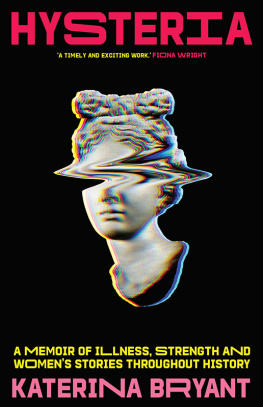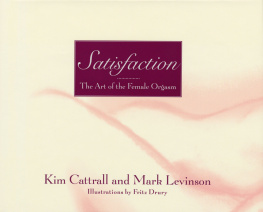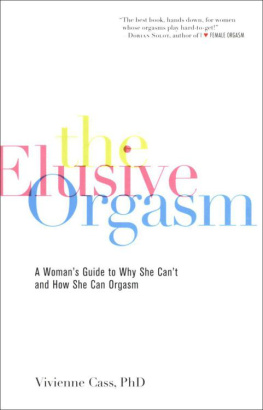PRAISE FOR THE TECHNOLOGY OF ORGASM
As historian Rachel Maines describes in her exhaustively researched if decidedly offbeat work, the vibrator was developed to perfect and automate a function that doctors had long performed for their female patients: the relief of physical, emotional and sexual tension through external pelvic massage, culminating in orgasm.Natalie Angier, New York Times
Wryly chronicles the attitude toward womens sexuality in the medical and psychological professions and shows, with searing insight, how some ancient biases are still prevalent in our society A pioneering and important book, this window into social and technological history also provides a marvelously clear view of contemporary ideas about womens sexuality.Publishers Weekly
In her exemplary historical analysis of the machines that go bump and grind in the night, Rachel Maines uncovers more than a mundane evolution of technology. After explaining how she came to take the vibrator seriously, she makes an excellent case why everyone else should, too.Elizabeth Millard, In These Times
An astonishing, amusing, and at times painful history of orgasm in women One doctor accused [Maines] of writing more to titillate than to enlighten. However, in her painstakingly researched and thoroughly engaging book, Maines proves that both effects are possible.Anna Watson, Natural Health
An enormously entertaining and valuable contribution to the study of this countrys sexual heritage.Marianna Beck, Libido
The Technology of Orgasm is a stunning book, not just for its depth of research and command of its subject but also for its humor and irony and pointed conjectures about gaps in medical knowledge.Lindsay Lane, Austin Chronicle
With lively writing and solid research, an independent scholar provides an engaging case study of vibrators.Choice
Mainess genuine enthusiasm for research and social inquiry make this book enjoyable and informative; at the same time it is rife with paradigm-shifting revelations.Carolyn Kuebler, Rain Taxi Review of Books
Meticulously documents what amounts to a secret history of female sexual arousal I dont believe it would be an exaggeration to say that Mainess argument contributes to the great tradition of brilliant, scientifically-based debunking begun by the likes of Galileo.Annalee Newitz, New York Press
This book is a masterpiece of material culture history, an important and original work of scholarship. Maines takes an apparently trivial artifact and demonstrates that it is, in fact, of enormous cultural significance.Ruth Schwartz Cowan, author of A Social History of American Technology
Refreshing By applying a gendered analysis to the material culture of vibrators, Maines extends the history of technology to embrace cultural history, the history of medicine, and the history of sexuality. Her engaging style, peppered throughout with dry wit, makes this short book a delightful read for historians (and nonhistorians) of all stripes.Elizabeth Siegel Watkins, Journal of American History
THE
TECHNOLOGY
OF
ORGASM
JOHNS
HOPKINS
STUDIES
IN THE
HISTORY OF
TECHNOLOGY
Merritt Roe Smith
Series Editor
THE
TECHNOLOGY
OF
ORGASM
Hysteria,
the Vibrator,
and Womens
Sexual
Satisfaction
RACHEL P. MAINES

For my
mother,
who
taught me
that
intellectual
freedom
is worth
fighting for
1999 The Johns Hopkins University Press
All rights reserved. Published 1999
Printed in the United States of America on acid-free paper
Johns Hopkins Paperbacks edition, 2001
2 4 6 8 9 7 5 3
The Johns Hopkins University Press
2715 North Charles Street
Baltimore, Maryland 21218-4363
www.press.jhu.edu
A catalog record for this book is available from the British Library.
The Library of Congress has cataloged the hardcover edition of this book as follows:
Maines, Rachel P.
The technology of orgasm : hysteria, the vibrator, and womens sexual
satisfaction / Rachel P. Maines.
p. cm. (Johns Hopkins studies in the history of technology ;
new ser., no. 24)
Includes bibliographical references and index.
ISBN 0-8018-5941-7 (alk. paper)
1. WomenSexual behaviorHistory. 2. Female orgasmHistory.
3. AnorgasmyHistory. 4. MasturbationHistory. 5. VibratorsHistory.
I. Title. II. Series.
HQ29.M35 1998
306.708209dc21 98-20213
ISBN 0-8018-6646-4 (pbk.)
CONTENTS
1
THE JOB NOBODY WANTED
2
FEMALE SEXUALITY AS HYSTERICAL PATHOLOGY
3
MY GOD, WHAT DOES SHE WANT?
4
INVITING THE JUICES DOWNWARD
5
REVISING THE ANDROCENTRIC MODEL
PREFACE
When I was a teenager a family friend said I was the kind of kid who would come home from school and ask permission to undertake some risky venture by saying, But Mummy! You have to let me! Nobodys doing it! Ive since decided that this is the judgment of my character I would want carved on my tombstone. The research I have set forth in this book is perhaps the most conspicuous example to date of my fascination with topics that nobody is doing.
When I first encountered vibrator advertisements in turn-of-the-century womens magazines in 1977, my reaction to their turgid prose was to assume that I simply had a dirty mind. I was, after all, twenty-seven years old, between marriages, a very angry feminist, and inclined to interpret everything I saw or read as some manifestation of the war between the sexes. A few years earlier, still in the throes of my first marriage, I had received Shere Hites original questionnaire about womens sexuality; the prospect of responding to it was too depressing to contemplate. The same year I saw the vibrator ads, I read The Hite Report, which shed new light not only on my own experiences but on those of my women friends.
I am often asked, when I present papers at meetings, how I managed to find this esoteric topic. My usual reply is that I didntit found me. The advertisements I found fell on a prepared mind, or at the very least, on prepared hormones. Since graduating from college in 1971 (in classics, with emphasis on ancient science and technology), I had been interested in the textile arts, and I spent two years wondering naively why it was so difficult to find any serious, well-researched histories of the subject.
Needlework proved to be an exciting and illuminating focus of research. It had a very rich primary literature plus a heritage of more artifacts than any one human being could live long enough to examine, but twenty years ago there were very few secondary sources and virtually no bibliographic access. Because my early interests had been in late nineteenth- and early twentieth-century American crochet, tatting, knitting, and embroidery, which were at that time poorly represented in the cataloged collections of large museums, there was nothing for it but to dive headfirst into the enormous unindexed sea of popular needlework publications, by the simple but laborious method of sitting down with whatever piles of them I could find and turning one page after another. In 1976 I was invited to present a paper on needlework history at a conference on womens history organized by Louise Tilly at the University of Michigan; it was later published as American Needlework in Transition, 18801930. As I doggedly turned the pages of Modern
Next page








